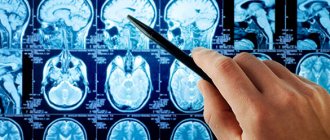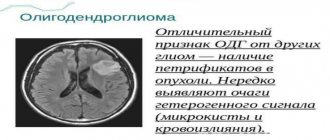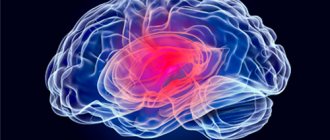Causes of brain germinoma
There is no clear opinion about the cause of the formation of brain germinoma. Scientists and oncologists are more inclined to the version of the disorder in the process of embryogenesis. There is a so-called dysontogenetic theory of the occurrence of this type of tumor. According to this theory, brain germinoma occurs as a result of disorders of tissue differentiation and tissue migration at the very first stages of embryogenesis in the first trimester of pregnancy. The basis of this hypothesis is largely based on the fact that neoplasms are more often detected in people at a young age.
Germinoma is usually classified as a type of embryonic tumor, and these neoplasms arise and develop even before the full formation of the fetus from the rudiments of embryonic tissues. The reason is a violation of embryogenesis, which occurs as a result of changes in the structure of chromosomes and mutation of genes that control the normal development of embryogenesis.
Factors that induce changes and disturbances in embryogenesis may have an indirect or direct effect on the body of the expectant mother. Such provocateurs include contact with toxic substances during pregnancy, the influence of radioactive substances, various types of infections (measles, herpes, severe stages of influenza). The risk factor will also be the influence of carcinogens.
Rekomed - Choosing a clinic for the treatment of germinoma
The Rekomed company will help you choose a clinic and a doctor, organize a trip for consultation, diagnosis, treatment or surgery. We will provide all coordination services for you and will help in solving organizational issues throughout the treatment. It is important to note that payment for treatment is always made directly to the clinic’s cash desk at the clinic’s prices.
Contact us by phone or use the “doctor” form to send your request.
doctor
| Rating | 1223 views | Recommend to friends | Roman KM |
Where to treat Germinoma?
Samsung Medical Center
Irwon-Dong, Gangnam-Gu, Seoul Korea View on map
0 positive review 0 negative review
Founded in 1994, already in 1996 the medical facility was recognized as a “Hospital of Presidential Standards.” In addition, the international department of the center is recognized as the best Korean clinic for receiving foreigners. So, not only patients living in Korea, but also patients specially coming for treatment turn to Samsung. Read more >>>
Cheongsim International Medical Center
267-177, Misari-ro, Seorak-myeon, Gapyeong-gun, Gyeonggi-do, Korea View on map
1 positive review 0 negative review
International medical practice combines Western and Eastern methods and approaches to the treatment of vomiting. Thus, modern technologies are favorably combined with oriental subtleties, and acupuncture, all kinds of moxibustion and preparations based on plant extracts significantly speed up recovery. Read more >>>
National Cancer Center of Korea
323 Ilsan-ro, Ilsandong-gu, Goyang-si Gyeonggi-do, Korea View on map
0 positive review 0 negative review
The National Cancer Center specializes in cancer. It operates six centers dedicated to the most common cancer diseases in the world. 180 highly qualified oncologists, whose research is published in reputable scientific publications, 430 nurses, as well as the latest technical equipment, make it possible to effectively combat the scourge of our century. Read more >>>
University Hospital Hamburg-Eppendorf
Martinistr. 52, Hamburg, Germany View on map
0 positive review 0 negative review
University Hospital Hamburg-Eppendorf (German: Universitätsklinikum Hamburg-Eppendorf) is a medical center in the North of Germany, located in the Eppendorf district of Hamburg. Read more >>>
Concern Clinics of St. Antonius
Birkenallee 18, Wegberg, Germany View on map
0 positive review 0 negative review
The St. Antonius Clinics concern is an association of eleven specialized clinics covering all areas of modern medicine; 30 medical departments; 1,600 hospital beds; 50,000 inpatients per year; about 3,500 first-class specialists. Read more >>>
Charite Clinic
Charitestraße 1, 10117 Berlin, Germany View on map
0 positive review 0 negative review
One of the oldest medical institutions in Germany, the Charite Clinic was founded in 1710. The level of this university hospital, which in addition to providing medical care also offers fundamental training for doctors and scientists, is extremely high. Read more >>>
University Hospital Dusseldorf
Moorenstr. 5, Düsseldorf, Germany View on map
0 positive review 0 negative review
The participation of the University Hospital of Düsseldorf in various international medical projects allows the application of progressive techniques in practice, which makes treatment even more effective. Read more >>>
University Hospital Münster
Domagkstraße 5, Münster, Germany View on map
0 positive review 0 negative review
The University Hospital of Münster is one of the oldest and largest medical centers not only in Germany, but also in Europe. The history of the clinic is inextricably linked with the medical faculty of the University of Münster, which allowed and allows the use of Read more>>>
Clinic "Assuta"
Tel-Aviv, Israel View on map
0 positive review 0 negative review
The Assuta Private Clinic, one of the most popular medical institutions in Israel, was founded in Tel Aviv in 1934 by Dr. Ben-Zion Harel, his son and repatriated doctors from Germany. Now this is a whole network of private clinics: 4 hospitals, medical complexes More >>>
Symptoms of brain germinoma
The clinical picture of brain germinoma largely depends on its location. Localization of brain germinoma - deep structures of the brain - area of the pineal gland, third ventricle.
One of the first signs of this neoplasm will be impaired blood flow and hydrocephalus as a consequence. Patients often complain of a bursting headache that is not relieved by analgesics or other painkillers. There is also a feeling of pressure in the eyes, constant nausea, independent of meals, and at times even vomiting. Visual impairment is often observed. This is explained by the fact that germinoma is localized near the chiasm of the optic nerves and, growing, infringes on them. Patients focus on double vision, visual field defects, farsightedness or myopia.
The clinical picture of brain germinoma is also characterized by deterioration or partial loss of memory, mental disorders, and emotional instability. In some cases, various kinds of neuroendocrine syndromes such as diabetes insipidus, as well as menstrual irregularities, anovulation, amenorrhea in women and disorders in the hypothalamic-pituitary system may be observed. Developmental disorders of puberty are also diagnosed. All these symptoms are explained by the location of the tumor near the hypothalamus.
Clinical picture
The clinical picture of this disease is characterized by diversity. And first of all, it is determined by where the tumor is located. Most common localizations:
In much more rare cases, such tumors are diagnosed in the mediastinum, retroperitoneum, stomach, neck (that is, in the nasopharynx), bladder, liver, and vagina.
Figure 1. Variants of location of germ cell formations in children.
Diagnosis of brain germinoma
The first diagnostic conclusions are made during the first examination by a neurologist. A neurological examination and questioning of the patient, his complaints and accents in the characteristics of general well-being makes it possible to establish or suspect the presence of hydrocephalus.
Methods for diagnosing brain germinoma:
- Echo-encephalogram. Firstly, it allows you to diagnose intracranial pressure, and secondly, in the case of a large tumor, this diagnostic method can reveal displacement of the deep structures of the brain.
- Tomographic methods - CT and MRI of the brain. They make it possible to identify the nature of the tumor, location and size. Almost half of patients diagnosed with brain germinoma have a clinical picture of tumor infiltration of the visual tuberosities and petrification in the middle (the so-called butterfly symptom). This diagnosis can be confirmed by the presence of tumor bodies in the lateral ventricles and metastases in the infundibular region of the third ventricle.
- Biochemical blood test - establishing markers of hCG, ACE, PAL.
- Steretactic brain biopsy. This method will be the most accurate in making a diagnosis, since a laboratory examination of the tumor body is performed. In some cases, such a study may not give accurate results if the tumor is heterogeneous.
- Morphological examination of tumor areas after its removal. The difficulty of this method is in localizing the tumor in the deep structures of the brain, so doctors often prefer stereotactic biopsy.
Brain germinoma has a similar clinical picture to a number of neoplasms in the central nervous system, and therefore requires careful diagnosis and differentiation from diseases with similar symptoms. Among these diseases:
- astrocytoma;
- glioma;
- ganglioneuroma;
- hematoblastoma;
- medulloblastoma;
- brain abscess;
- intracerebral hematoma;
- cystosis in the third ventricle.
Treatment
The method of treating germinoma depends on the volume of the tumor, location, and the presence of complications. In uncomplicated cases, the possibility of choosing a radical method of surgical treatment or less traumatic radiosurgical treatment using CyberKnife (stereotactic radiosurgery) .
Treatment of germinoma using the CyberKnife system
Radiosurgical system CyberKnife
With the advent of CyberKnife in the clinical practice of the world's leading oncology centers, treatment of germinomas ceased to be carried out exclusively by surgical methods, which, due to the development of germinomas in the deep structures of the brain, led to serious, often irreparable neurological damage associated with access to the tumor itself. Today, the choice of tactics for treating germinoma is limited only by the qualifications of the attending physician, who in modern conditions should know about the advantages of radiosurgery, and the patient’s ability to access treatment with CyberKnife.
The greatest effectiveness is shown by combined treatment of germinomas, consisting of high-dose radiosurgery and subsequent chemotherapy of the tumor. In this case, the entire volume of germinoma, determined by a combination of CT and MRI data, receives an equal dose, leading to the biological death of tumor cells, and healthy tissues surrounding the tumor receive minimal doses of ionizing radiation.
Chemotherapy after germine treatment on CyberKnife is designed to combat possible tumor micrometastases and single tumor cells that may not have received a sufficient dose of radiation due to the complex shape of the tumor or its growth into those brain structures to which applying a single therapeutic dose of radiation for the entire volume can be dangerous .
Germinoma - radiosurgical treatment of a brain tumor on CyberKnife without surgery, treatment plan. The red outline indicates the area that will be exposed to a high dose of ionizing radiation
Treatment of germinoma using the CyberKnife radiosurgical system is carried out on an outpatient basis. Many patients do not leave their usual work schedule, without advertising the fact of the disease and treatment to their friends.
If the tumor is difficult to reach, but its size exceeds those recommended for the effective use of CyberKnife (radiosurgery), a stereotactic biopsy is performed and high-precision IMRT radiation therapy is started on the tumor area. Combined radiation treatment is combined with rational chemotherapy.
IMRT radiation therapy in the treatment of germinoma
Elekta linear accelerator
Germinoma is a brain tumor that occurs during embryonic development. But in the early stages, when a non-surgical technique - radiosurgery on CyberKnife - can be used to combat the tumor, it is extremely difficult to detect and identify germinoma. For this reason, the most effective treatment involves removing part of the tumor located outside the critical structures of the brain and highly precise irradiation of those areas that cannot be removed.
One of the most accurate methods of delivering ionizing radiation, which allows delivering an exact dose that is already destructive for germinoma tumor tissues, but still tolerant for healthy brain cells, concentrated precisely in a given volume, is high-precision radiation therapy IMRT.
Targeted delivery of a given dose of ionizing radiation (leading to the stop of biological processes in the tissues of the tumor) into a given volume with controlled delivery of radiation.
The accuracy of treatment is determined by the creation of a model of the location of the remaining part of the tumor in the brain, which is built on the basis of CT and MRI images in a special program. Using this model, the radiologist determines and plots the contours of the germinoma and healthy tissues, for each of which the radiation therapist sets the permissible minimum and maximum doses.
Germinoma - radiation treatment plan - high-precision IMRT radiation therapy, which allows you to deliver a high dose to large tumors with fields of complex shape, minimizing the doses received by healthy tissues.
The medical physicist then develops a plan for the passage of the radiation fields, each of which will have a different shape and will be delivered from different positions of the linear accelerator. Thus, the required radiation dose will be limited to the areas of mutual intersection of the fields, and healthy tissues along the path of the fields will receive a small dose that will not lead to irreversible damage.
The duration of treatment of germinoma using a high-precision linear accelerator is 20-30 daily sessions, during which the patient is conscious and lies in a comfortable position, his head is fixed with an elastic individual mask to avoid displacement. Due to the non-invasive nature of the treatment method, the patient returns to his normal daily routine after a session (fraction) of treatment.
The prognosis depends on the histological structure and operability of the tumor. As a rule, germinoma is sensitive to both chemotherapy and radiation therapy. The five-year survival rate exceeds 85%.
Treatment of brain germinoma
The most common treatment strategy for brain germinoma is radiation therapy. If the patient’s age is too young, their general condition does not allow radiation therapy, or there are contraindications, then polychemotherapy is prescribed. Sometimes surgery will be a mandatory and forced method of treatment and may be accompanied by radiation or chemotherapy. But such a complex method of treating this disease is extremely undesirable for young or child patients, as it entails severe intoxication of the entire body.
Surgery
Surgical treatment of brain germinoma can be carried out in various ways and is performed when an accurate diagnosis is made and the location, nature and size of the tumor is established. Often, surgical treatment is the only possible method, since other methods will be ineffective. In some cases, surgical intervention requires additional procedures - ventriculocisternostomy or ventriculoperitoneostomy.
Contraindications for surgical treatment of brain germinoma may include inoperable location of the tumor or disseminated tumor growth, as well as multiple foci. If the size of the tumor is small, then it is advisable to use radiosurgery methods. The essence is a single exposure to the location of the tumor with a high dose of radiation.
Treatment of the disease is within the competence of specialized departments of neurosurgery, which are equipped with equipment and a computer imaging neuronavigation system.
Prognosis and prevention of brain germinoma
The main methods of preventing brain germinoma can be considered the exclusion of any negative impact on the body of the expectant mother. A pregnant woman should lead a healthy lifestyle and avoid contact with radioactive and toxic substances.
This disease, if detected in the early stages, responds well to chemotherapy and radiation therapy. In the future, to monitor your condition and the course of the disease after treatment, you must consult a neurologist at least once a year. Even with surgery, the prognosis can be quite encouraging - the survival rate after such operations is approximately 85 percent.










